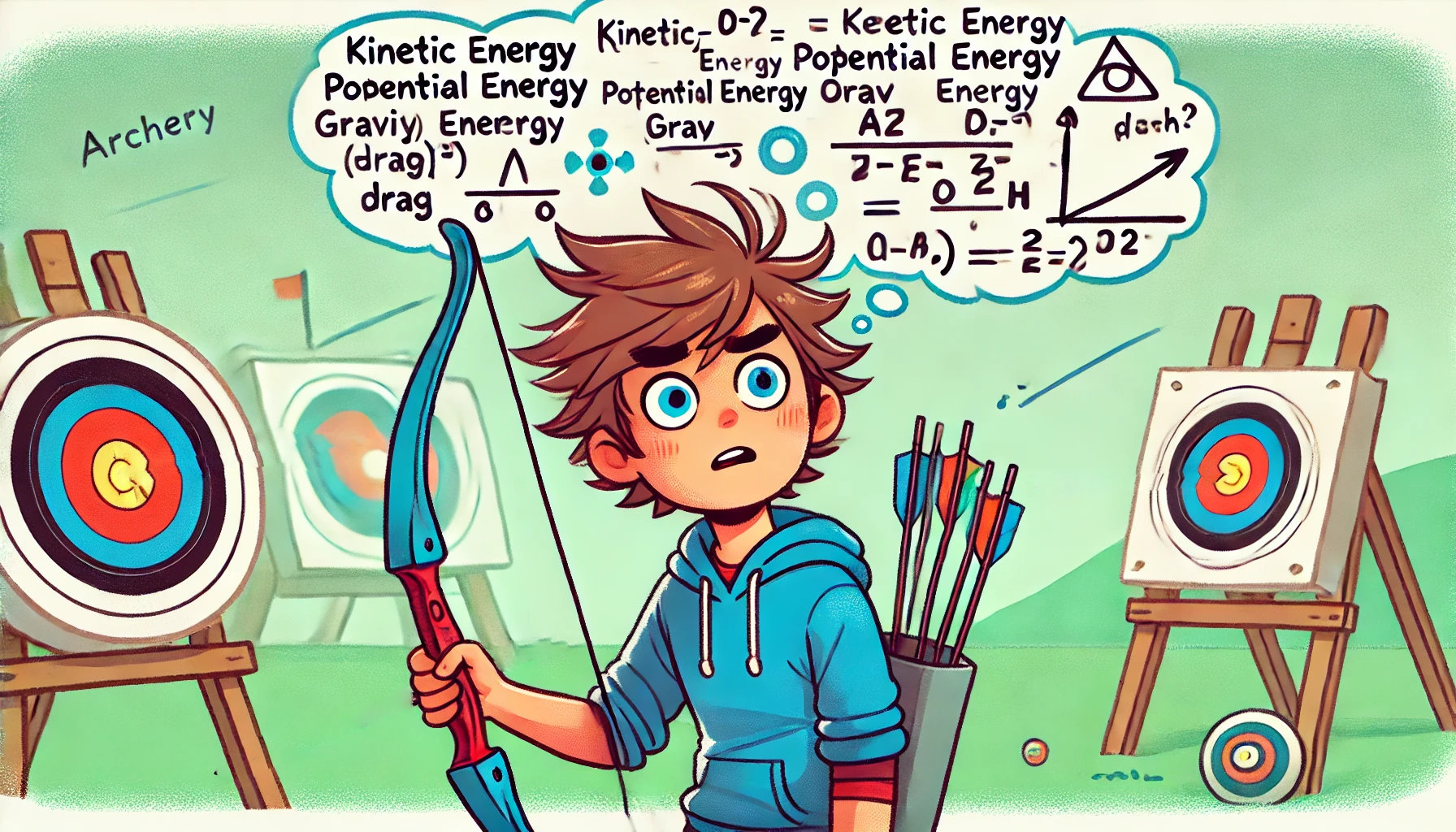Archery isn’t just about strength and precision; it’s also a symphony of scientific forces at play. In this article, we’ll explore the physics behind every shot—explained simply, so anyone can follow along and appreciate the magic behind the bow and arrow.
1. The Orchestra of Forces: What Happens When You Draw and Release
When you pull back the bowstring, you’re storing energy in the bow’s limbs like stretching a rubber band. This stored energy is called potential energy. The moment you release the string, that energy begins to transform into kinetic energy, sending the arrow flying.
- Push and pull in harmony: When you draw the bowstring, you’re not just pulling back—you’re also pushing forward with your bow hand. This push-pull balance is like the two hands of a conductor leading the orchestra. Together, they store energy and prepare for the release.
- Potential energy: The stored energy in the drawn bow.
- Kinetic energy: The energy that the arrow has as it flies through the air.
Why it matters: The longer your draw length (the distance you pull the string), the more energy the bow transfers to the arrow, increasing speed and power.
Comparison to a slingshot: The farther you pull back the band, the more energy you store—and the faster the projectile flies.
Crossbow comparison: Crossbows have shorter draw lengths, so they compensate with higher draw weights to achieve similar kinetic energy.
Violin string metaphor: When you release the string, it’s like plucking a violin string—the energy is released in a resonant motion, sending the arrow flying.
2. The Battle of Tension and Compression
When the bow bends, two forces act on the limbs:
- Tension: The outer side of the limb (facing away from you) stretches.
- Compression: The inner side of the limb compresses.
It’s like bending a plastic ruler—one side stretches, while the other presses inward. This balance between tension and compression gives the bow its power and flexibility.
Fun fact: Traditional horn bows use horn on the inner side (to handle compression) and sinew on the outer side (to handle tension). This clever combination makes for an incredibly resilient and powerful bow.
3. The Role of Arrow Weight: Heavy vs. Light Arrows
The mass of the arrow affects its flight characteristics.
- Heavier arrows:
- Fly more steadily and resist wind better.
- Hit with more momentum (ideal for hunting or long distances).
- Travel slower, requiring you to aim higher.
- Lighter arrows:
- Fly faster and have a flatter trajectory.
- Are more affected by wind.
- Lose speed quickly due to air resistance.
Analogy: Imagine throwing two balls of the same size—one is a tennis ball, and the other is a heavy boule. The tennis ball flies faster but feels light, while the boule moves slower but stays stable.
4. Impact Force: The Balance Between Speed and Mass
When an arrow hits the target, its impact depends on its speed and mass.
A small pebble thrown quickly may sting, but a slow-moving bowling ball will knock you over.
Why mass matters: A heavier arrow retains more momentum over long distances, while a lighter arrow loses energy faster due to air resistance.
Practical takeaway: Long-distance archers often choose heavier arrows because they maintain their force throughout the flight.
5. Gravity and Drag: The Arrow’s Constant Companions
When an arrow is in flight, two main forces act on it:
- Gravity: Pulls the arrow downward in a vertical direction.
- Drag: Air resistance that slows the arrow’s forward motion.
The forward motion of the arrow comes from the kinetic energy imparted by the bow when released—there is no ongoing forward force.
No matter how fast or powerful your shot, gravity will always pull the arrow down. This is why archers aim slightly above their target.
Visual example: Imagine rolling a ball on the floor. It starts with some speed but gradually slows and always falls if the surface slopes downward.
6. Trajectory: The Curve of an Arrow’s Flight
The path of an arrow forms a curve, called its trajectory, due to gravity.
- A short-distance shot has a shallow arc.
- A long-distance shot has a steep, rainbow-like arc.
Visual tip: Picture a rainbow—short distances result in a flatter arc, while long distances require more elevation to compensate for gravity.
7. Air Resistance: Fighting Against the Wind
As the arrow flies, it pushes against the surrounding air. This force, called drag, tries to slow the arrow.
Why fletchings help: The small feathers or plastic vanes at the back of the arrow stabilise it by balancing these forces.
Shaft thickness matters: A thicker arrow shaft creates more drag, slowing it down. A thinner shaft has less drag and flies faster.
Fletching height matters too: Taller fletchings create more drag but provide greater stability. Lower-profile fletchings reduce drag but may stabilise the arrow more slowly, especially in windy conditions.
8. Plastic Vanes vs. Feathers: A Tale of Two Fletchings
The type of fletching affects drag and stability:
- Plastic vanes: Durable and water-resistant, creating consistent drag for straight, stable flights.
- Feathers: Lighter and softer, creating more drag at first but stabilising the arrow quickly. However, they’re more sensitive to moisture.
Fun fact: Flu-flu arrows use large, spiraled fletchings made of feathers to create significant drag, slowing the arrow down quickly—ideal for short-range or aerial shots.
9. Point of Balance: How Tip Weight Affects Flight
The weight of the arrow tip influences how it behaves:
- Heavier tips: Shift the balance forward, increasing stability and reducing the need for fletchings.
- Lighter tips: Keep the balance closer to the center, which increases speed but can cause wobbling.
Analogy: Imagine a see-saw with weights at each end. A heavier weight makes one side stable but harder to move, just like a heavy arrow tip.
Fun fact: In flight shooting, archers use lighter tips and centrally balanced arrows designed to maximize range rather than precision.
10. Practical Experiment: Test the Science Yourself
Try this simple test at the range:
- Use three arrows with different point weights.
- Shoot each one at the same target from the same distance.
- Record their landing points.
What to observe:
- How much higher you need to aim with heavier arrows.
- How the arrow’s stability changes.
- How varying distances affect accuracy.
The Art and Physics of Archery
Understanding the forces at work makes each shot more meaningful. You’re not just loosing an arrow—you’re working with gravity, energy, and aerodynamics. By mastering the science, you can deepen your technique and love for archery.
As you take aim, remember: you’re not just an archer—you’re a physicist in motion, mastering the elements with every shot.
What discoveries have you made in your practice? Share your thoughts with the Artemis Archery community—and may your arrows fly true!





0 Comments